________________
CHAPTER I
41
see all things in all places and of all times. The omniscient will have to be a dirty being, because, being necessitated by the function of seeing, he will have to come into contact with so many dirty things. There is a limit to visionary and knowing ability, and it cannot be stretched beyond that; so none can be able to see things which are super-sensuous. None of the five proofs can justify any one's omniscience. The so-called omniscients do not agree among themselves; their words are against Vedas, whose authority is unquestionable; and no omniscient is ever come across by anybody: so omniscience is an impossibility. The all-knowledge attributed to Brahman means only self-knowldege."
This attack of Kumārila has twofold handicaps: first, his hands are tied down by the above tenets of his school and, secondly, he has not distinguished sense-perception from omniscience he attacks omniscience as if it is senseperception intensified and magnified. Kundakunda has plainly told us that "senses have no part to play in omniscience; it is the spirit, being a knower by nature and essentially constituted of knowledge that comes face to face with the complex reality, and comprehends it immediately and simultaneously in its entirety with no effort on his part and with no effect on his spiritul constitution."1
This verse of Āpta-mīmāṁsā is perhaps the first in Jaina literature where an attempt to establish omniscience by reasoning is made. Kevala-jñāna, which is the same as omniscience, was mentioned by Kundakunda, who was earlier than Samantabhadra, but he had taken it, as will appear from the commentary on the following verse of Apta-mīmāmsā as an essential characteristic of the Holy One. He did not make any attempt to justify the existence of quality or refute any argument against it. The Niryuktis make some reference to this subject, but the voluminous literature which subsequently grew up refuting and
1. Pravachana-sāra edited by A.N. Upadhye, Introduction, page LXXVIII. For a detailed comparative discussion, the reader may consult pages LXXII--LXXX.




